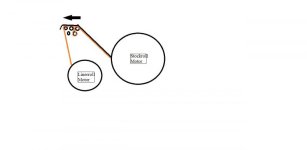I am working on maintaining constant web tension in the support liner for my material that is fed into my machine.
Background Info:
My material is feed into the machine via cassettes that store the material. In each cassette there are two rolls; a stock roll that stores the material after windup and a liner roll that stores the support liner during unwind. Each of these drives has independent motors that are controlled by their own VFD. The stock roll motor is speed controlled so as to have the same speed as the feed conveyors in the machine, while the liner roll is supposed to be torque controlled so that we can maintain constant tension during the unwind process to help with peeling the material from the liner.
I am able to calculate the speed for my stock roll at varying diameters to match the feed conveyors' linear speed but I am having trouble calculating the torque and speed of the liner roll to maintain constant tension.
Also, I think it might be important to note that the feed is not constant. The feed duration is maybe ten seconds long.
Any input will be greatly appreciated.
Thank you.

Background Info:
My material is feed into the machine via cassettes that store the material. In each cassette there are two rolls; a stock roll that stores the material after windup and a liner roll that stores the support liner during unwind. Each of these drives has independent motors that are controlled by their own VFD. The stock roll motor is speed controlled so as to have the same speed as the feed conveyors in the machine, while the liner roll is supposed to be torque controlled so that we can maintain constant tension during the unwind process to help with peeling the material from the liner.
I am able to calculate the speed for my stock roll at varying diameters to match the feed conveyors' linear speed but I am having trouble calculating the torque and speed of the liner roll to maintain constant tension.
Also, I think it might be important to note that the feed is not constant. The feed duration is maybe ten seconds long.
Any input will be greatly appreciated.
Thank you.





